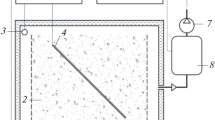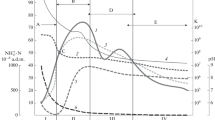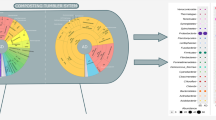Abstract
Composting is characterized by dramatic changes in microbial community structure, to a high extent driven by changes in temperature and in the composition of the organic substrate. This study focuses on the interrelationships between decomposition of major classes in the organic material and dynamics in microbial populations during thermophilic composting of source-separated organic household waste.
Experiments were performed in a 200-L laboratory reactor at 16, 2.5, and 1% O2 in the compost atmosphere. Major classes of carbon constituents were analyzed by chemical methods, and the microbial biomass and community structure determined by fatty acid analyses with phospholipid fatty acids (PLFA) and total ester-linked fatty acids (EL) methods. At all three O2 levels, the process was characterized by a rapid increase in microbial activity and biomass in the early thermophilic phase, although this period was delayed at the lower O2 concentrations. Starch and fat were the main substrates utilized at all three O2 levels during this period. The depletion of the starch fraction coincided with the beginning of a microbial biomass decrease, suggesting thatstarch is an important carbon substrate for the growth of thermophilic microorganisms during composting. Growth yields in the microbial community based on consumption of major carbon constituent classes in the high-activity period fell between 22 and 28%. Multivariate statistical analysis of changes in fatty acid composition revealed small, but statistically significant differences in the microbial community succession. At 16% O2, 10Me fatty acids from Actinomycetes and cyclopropyl fatty acids (from Gram-negative bacteria) became more important with time, whereas 18:1ω7t was characteristic at 2.5 and 1% O2, indicating a more stressed bacterial community at the lower O2 concentrations.
Although adequate composting was achieved at O2 levels as low as 2.5 and 1%, it is not recommended to compost at such low levels in large-scale systems, because the heterogeneous gas transport through the material in these systems might lead to anaerobic conditions and inefficient composting.





Similar content being viewed by others
References
TH Anderson KH Domsch (1986) ArticleTitleCarbon assimilation and microbial activity in soil Z Pflanzenernahr Bodenkd 149 457–468 Occurrence Handle1:CAS:528:DyaL28Xltlars74%3D
Anonymous (1984) Off J Eur Communities 15 29–30
CF Atkinson DD Jones JJ Gauthier (1996) ArticleTitleBiodegradabilities and microbial activities during composting of oxidation ditch sludge Compost Sci Util 4 84–96
E Bååth (2003) ArticleTitleThe use of neutral lipid fatty acids to indicate the physiological conditions of soil fungi Microb Ecol 45 373–383 Occurrence Handle12704558
B Beck-Friis S Smårs H Jonsson Y Eklind H Kirchmann (2003) ArticleTitleComposting of source-separated household organics at different oxygen levels: gaining an understanding of the emission dynamics Compost Sci Util 11 41–50
T Beffa M Blanc PF Lyon G Vogt M Marchiani JL Fischer M Aragno (1996) ArticleTitleIsolation of Thermus strains from hot composts (60 to 80 degrees C) Appl Environ Microbiol 62 1723–1727 Occurrence Handle8633870 Occurrence Handle1:CAS:528:DyaK28Xislylurg%3D
S Bengtsson K Larsson (1990) ArticleTitleDetermination of starch in a low-injection system with immobilized enzymes Swed J Agric Res 20 27–29 Occurrence Handle1:CAS:528:DyaK3MXkt1Okurw%3D
B Berg K Hannus T Popoff O Theander (1982) ArticleTitleChanges in organic chemical components of needle litter during decomposition. Long-term decomposition in a Scots pine forest. I. Can J Bot 60 1310–1319 Occurrence Handle1:CAS:528:DyaL38XmtFCqu7Y%3D
B Berg G Ekbohm C McClaugherty (1984) ArticleTitleLignin and holocellulose relations during long-term decomposition of some forest litters. Long-term decomposition in a Scots pine forest. IV. Can J Bot 62 2540–2550 Occurrence Handle1:CAS:528:DyaL2MXht1yqur4%3D
M Blanc L Marilley T Beffa M Aragno (1999) ArticleTitleThermophilic bacterial communities in hot composts as revealed by most probable number counts and molecular (16SrDNA) methods FEMS Microbiol Ecol 28 141–149 Occurrence Handle1:CAS:528:DyaK1MXhvFCrtr4%3D
VR Cahyani A Watanabe K Matsuya S Asakawa M Kimura (2002) ArticleTitleSuccession of microbiota estimated by phospholipid fatty acid analysis and changes in organic constituents during the composting process of rice straw Soil Sci Plant Nutr 48 735–743 Occurrence Handle1:CAS:528:DC%2BD38XoslWjtr0%3D
L Carpenter-Boggs AC Kennedy JP Reganold (1998) ArticleTitleUse of phospholipid fatty acids and carbon source utilization patterns to track microbial community succession in developing compost Appl Environ Microbiol 64 4062–4064 Occurrence Handle9758843 Occurrence Handle1:CAS:528:DyaK1cXms1emsr8%3D
M–H Charest CJ Beauchamp (2002) ArticleTitleComposting of de-inking paper sludge with poultry manure at three nitrogen levels using mechanical turning: behavior of physico-chemical parameters Bioresour Technol 81 7–17 Occurrence Handle10.1016/S0960-8524(01)00104-3 Occurrence Handle11708756 Occurrence Handle1:CAS:528:DC%2BD3MXnsVKlsLw%3D
M–H Charest H Antoun CJ Beauchamp (2004) ArticleTitleDynamics of water-soluble carbon substances and microbial populations during the composting of de-inking paper sludge Bioresour Technol 91 53–67 Occurrence Handle10.1016/S0960-8524(03)00155-X Occurrence Handle14585622 Occurrence Handle1:CAS:528:DC%2BD3sXosVWrtLs%3D
PM Dees WC Ghiorse (2001) ArticleTitleMicrobial diversity in hot synthetic compost as revealed by PCR-amplified rRNA sequences from cultivated isolates and extracted DNA FEMS Microbiol Ecol 35 207–216 Occurrence Handle11295460 Occurrence Handle1:CAS:528:DC%2BD3MXisF2rsbY%3D
NJE Dowling F Widdel DC White (1986) ArticleTitlePhospholipid ester-linked fatty acid biomarkers of acetate-oxidizing sulphate-reducers and other sulphide-forming bacteria J Gen Microbiol 132 1815–1825 Occurrence Handle1:CAS:528:DyaL28XkslGmt70%3D
F Eiland M Klamer A Lind M Leth E Bååth (2001) ArticleTitleInfluence of initial C/N ratio on chemical and microbial composition during long term composting of straw Microb Ecol 41 272–280 Occurrence Handle11391465 Occurrence Handle1:CAS:528:DC%2BD3MXltFSjsr8%3D
Y Eklind B Beck-Friis S Bengtsson J Ejlertsson H Kirchmann B Mathisen E Nordkvist U Sonesson B Svensson L Torstensson (1997) ArticleTitleChemical characterization of source-separated organic household wastes Swed J Agric Res 27 167–178 Occurrence Handle1:CAS:528:DyaK1cXjtVKlsrs%3D
Y Eklind H Kirchmann (2000) ArticleTitleComposting and storage of organic household waste with different litter amendments: I. Carbon turnover Bioresour Technol 74 115–124 Occurrence Handle1:CAS:528:DC%2BD3cXjt1Ggu7c%3D
E Epstein (1997) Biochemistry E Epstein (Eds) The Science of Composting Technomic Publishing Lancaster 77–106
E Epstein (1997) Microbiology E Epstein (Eds) The Science of Composting CRC Press Washington, DC 53–76
MS Finstein LM Morris (1975) ArticleTitleMicrobiology of municipal solid waste composting Adv Appl Microbiol 19 113–151 Occurrence Handle242194 Occurrence Handle1:STN:280:DyaE28%2FlvVOqtQ%3D%3D
SD Frey VVSR Gupta ET Elliott K Paustian (2001) ArticleTitleProtozoan grazing affects estimates of carbon utilization efficiency of the soil microbial community Soil Biol Biochem 33 1759–1768 Occurrence Handle10.1016/S0038-0717(01)00101-8 Occurrence Handle1:CAS:528:DC%2BD3MXotFOlu74%3D
A Frostegård A Tunlid E Bååth (1991) ArticleTitleMicrobial biomass measured as total lipid phosphate in soils of different organic content J Microbiol Methods 14 151–163
RF Herrmann JF Shann (1997) ArticleTitleMicrobial community changes during the composting of municipal solid waste Microb Ecol 33 78–85 Occurrence Handle10.1007/s002489900010 Occurrence Handle9039768
WR Horwath LF Elliott (1996) ArticleTitleRyegrass straw component decomposition during mesophilic and thermophilic incubations Biol Fertil Soils 21 227–232 Occurrence Handle10.1007/BF00334896
M Kates (1986) Techniques of lipidology: isolation, analysis and identification of lipids RH Burdon PH Knippenberg Particlevan (Eds) Laboratory Techniques in Biochemistry and Molecular Biology, vol. 3 Elsevier Amsterdam 190–195
JD King DC White CW Taylor (1977) ArticleTitleUse of lipid composition and metabolism to examine structure and activity of estuarine detrital microflora Appl Environ Microbiol 33 1177–1183 Occurrence Handle1:CAS:528:DyaE2sXktlGmsro%3D Occurrence Handle16345244
M Klamer E Bååth (1998) ArticleTitleMicrobial community dynamics during composting of straw material studied using phospholipid fatty acid analysis FEMS Microbiol Ecol 27 9–20 Occurrence Handle1:CAS:528:DyaK1cXls1Oku7Y%3D
FCJ Michel CA Reddy LJ Forney (1993) ArticleTitleYard waste composting: studies using different mixes of leaves and grass in a laboratory scale system Compost Sci Util 1 85–96
FC Miller (1993) Composting as a process based on the control of ecologically selective factors F Blaine J Metting (Eds) Soil Microbial Ecology—Applications in Agricultural and Environmental Management Marcel Dekker New York 515–539
KM Nordström (1992) ArticleTitleEffect of growth phase on the fatty acid composition of Thermus spp. Arch Microbiol 158 452–455
M Pedro S Haruta M Hazaka R Shimada C Yoshida K Hiura M Ishii Y Igarashi (2001) ArticleTitleDenaturing gradient gel electrophoresis analyses of microbial community from field-scale composter J Biosci Bioeng 91 159–165 Occurrence Handle10.1263/jbb.91.159 Occurrence Handle16232968 Occurrence Handle1:CAS:528:DC%2BD3MXis1Kns7w%3D
S Peters S Koschinsky F Schwieger CC Tebbe (2000) ArticleTitleSuccession of microbial communities during hot composting as detected by PCR-single-strand-conformation polymorphism-based genetic profiles of small-subunit rRNA genes Appl Environ Microbiol 66 930–936 Occurrence Handle10.1128/AEM.66.3.930-936.2000 Occurrence Handle10698754 Occurrence Handle1:CAS:528:DC%2BD3cXhsFyrtrs%3D
HC Pinkart DB Ringelberg YM Piceno SJ Macnaughton DC White (2002) Biochemical approaches to biomass measurements and community structure analysis CJ Hurst RL Crawford (Eds) Manual of Environmental Microbiology ASM Press Washington, DC 101–113
J Ryckeboer J Mergaert K Vaes S Klammer D Clercq ParticleDe J Coosemans H Insam J Swings (2003) ArticleTitleA survey of bacteria and fungi occurring during composting and self-heating processes Ann Microbiol 53 349–410
B Schink (1988) Principles and limits of anaerobic degradation: environmental and technological aspects AJB Zehnder (Eds) Biology of Anaerobic Microorganisms Wiley New York 778–781
ME Schutter RP Dick (2000) ArticleTitleComparison of fatty acid methyl ester (FAME) methods for characterizing microbial communities Soil Sci Soc Am J 64 1659–1668 Occurrence Handle1:CAS:528:DC%2BD3cXntlGmu78%3D Occurrence Handle10.2136/sssaj2000.6451659x
S Smårs B Beck-Friis H Jonsson H Kirchmann (2001) ArticleTitleAn advanced experimental composting reactor for systematic simulation studies J Agric Eng Res 78 415–422
E Steen K Larsson (1986) ArticleTitleCarbohydrates in roots and rhizomes of perennial grasses New Phytol 104 339–346 Occurrence Handle1:CAS:528:DyaL2sXjtVWhtA%3D%3D
K Steger A Jarvis S Smårs I Sundh (2003) ArticleTitleComparison of signature lipid methods to determine microbial community structure in compost J Microbiol Methods 55 371–382 Occurrence Handle10.1016/S0167-7012(03)00187-8 Occurrence Handle14529958 Occurrence Handle1:CAS:528:DC%2BD3sXns12lsrc%3D
PF Strom (1985) ArticleTitleEffect of temperature on bacterial species diversity in thermophilic solid-waste composting Appl Environ Microbiol 50 899–905 Occurrence Handle4083885 Occurrence Handle1:CAS:528:DyaL2MXmtVSguro%3D
PF Strom (1985) ArticleTitleIdentification of thermophilic bacteria in solid-waste composting Appl Environ Microbiol 50 906–913 Occurrence Handle4083886 Occurrence Handle1:STN:280:DyaL287gt1WjtQ%3D%3D
I Sundh S Rönn (2002) Microbial succession during composting of source-separated urban organic household waste under different initial temperature conditions H Insam N Riddech S Klammer (Eds) Microbiology of Composting Springer-Verlag Berlin 53–64
MJ Swift OW Heal JM Anderson (1979) Decomposition in Terrestrial Ecosystems. Studies in Ecology, vol. 5 Blackwell Oxford
PJ Soest ParticleVan (1982) Nutritional Ecology of the Ruminant O&B Books Corvallis, OR, USA
P Virtue PD Nichols PI Boon (1996) ArticleTitleSimultaneous estimation of microbial phospholipid fatty acids and diether lipids by capillary gas chromatography J Microbiol Methods 25 177–185 Occurrence Handle10.1016/0167-7012(95)00095-X Occurrence Handle1:CAS:528:DyaK28XksFShtLs%3D
DC White RJ Bobbie JS Herron JD King SJ Morrison (1979) Biochemical measurements of microbial mass and activity from environmental samples JW Costerton RR Colwell (Eds) Native Aquatic Bacteria: Enumeration, Activity, and Ecology, ASTM STP 695 American Society for Testing and Materials Philadelphia, PA 69–81
SG Wilkinson (1988) Gram-negative bacteria C Ratledge SG Wilkinson (Eds) Microbial Lipids, vol. 1 Academic Press London 299–488
Acknowledgments
Financial support for this study was obtained from the Swedish Environmental Protection Agency and FORMAS (The Swedish Research Council for Environment, Agricultural Sciences and Spatial Planning).
Author information
Authors and Affiliations
Corresponding author
Rights and permissions
About this article
Cite this article
Steger, K., Eklind, Y., Olsson, J. et al. Microbial Community Growth and Utilization of Carbon Constituents During Thermophilic Composting at Different Oxygen Levels. Microb Ecol 50, 163–171 (2005). https://doi.org/10.1007/s00248-004-0139-y
Received:
Accepted:
Published:
Issue Date:
DOI: https://doi.org/10.1007/s00248-004-0139-y




